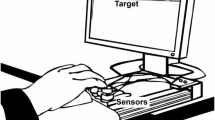Abstract
We explored posture-stabilizing multi-muscle synergies with two methods of analysis of multi-element, abundant systems: (1) Analysis of inter-cycle variance; and (2) Analysis of motor equivalence, both quantified within the framework of the uncontrolled manifold (UCM) hypothesis. Data collected in two earlier studies of patients with Parkinson’s disease (PD) were re-analyzed. One study compared synergies in the space of muscle modes (muscle groups with parallel scaling of activation) during tasks performed by early-stage PD patients and controls. The other study explored the effects of dopaminergic medication on multi-muscle-mode synergies. Inter-cycle variance and absolute magnitude of the center of pressure displacement across consecutive cycles were quantified during voluntary whole-body sway within the UCM and orthogonal to the UCM space. The patients showed smaller indices of variance within the UCM and motor equivalence compared to controls. The indices were also smaller in the off-drug compared to on-drug condition. There were strong across-subject correlations between the inter-cycle variance within/orthogonal to the UCM and motor equivalent/non-motor equivalent displacements. This study has shown that, at least for cyclical tasks, analysis of variance and analysis of motor equivalence lead to metrics of stability that correlate with each other and show similar effects of disease and medication. These results show, for the first time, intimate links between indices of variance and motor equivalence. They suggest that analysis of motor equivalence, which requires only a handful of trials, could be used broadly in the field of motor disorders to analyze problems with action stability.






Similar content being viewed by others
References
Almeida QJ, Wishart LR, Lee TD (2002) Bimanual coordination deficits with Parkinson’s disease: the influence of movement speed and external cueing. Mov Disord 17:30–37
Boonstra TA, van Vugt JPP, van der Kooij H, Bloem BR (2014) Balance asymmetry in Parkinson’s disease and its contribution to freezing of gait. PLoS One 9:e102493
Cavanaugh JT, Guskiewicz KM, Stergiou N (2005) A nonlinear dynamic approach for evaluating postural control: new directions for the management of sport-related cerebral concussion. Sports Med 35:935–950
Corcos DM, Gottlieb GL, Latash ML, Almeida GL, Agarwal GC (1992) Electromechanical delay: an experimental artifact. J Electromyogr Kinesiol 2:59–68
Criswell E, Cram JR (2011) Cram’s introduction to surface electromyography, 2nd edn. Jones and Bartlett, Sudbury
Danna-Dos-Santos A, Slomka K, Zatsiorsky VM, Latash ML (2007) Muscle modes and synergies during voluntary body sway. Exp Brain Res 179:533–550
d’Avella A, Bizzi E (2005) Shared and specific muscle synergies in natural motor behaviors. PNAS 102:3076–3081
d’Avella A, Saltiel P, Bizzi E (2003) Combinations of muscle synergies in the construction of a natural motor behavior. Nat Neurosci 6:300–308
DeWald JP, Pope PS, Given JD, Buchanan TS, Rymer WZ (1995) Abnormal muscle coactivation patterns during isometric torque generation at the elbow and shoulder in hemiparetic subjects. Brain 118:495–510
Falaki A, Lewis MM, Huang X, Latash ML (2016) Impaired synergic control of posture in Parkinson’s patients without postural instability. Gait Posture 44:209–215
Falaki A, Huang X, Lewis MM, Latash ML (2017) Dopaminergic modulation of multi-muscle synergies in postural tasks performed by patients with Parkinson’s disease. J Electromyogr Kinesiol 33:20–26
Feldman AG (1966) Functional tuning of the nervous system with control of movement or maintenance of a steady posture. II. Controllable parameters of the muscle. Biophysics 11:565–578
Feldman AG (1986) Once more on the equilibrium-point hypothesis (λ-model) for motor control. J Mot Behav 18:17–54
Feldman AG (2015) Referent control of action and perception: Challenging conventional theories in behavioral science. Springer, NY
Friedman J, Varadhan SKM, Zatsiorsky VM, Latash ML (2009) The sources of two components of variance: an example of multifinger cyclic force production tasks at different frequencies. Exp Brain Res 196:263–277
Goodman SR, Shim JK, Zatsiorsky VM, Latash ML (2005) Motor variability within a multi-effector system: experimental and analytical studies of multi-finger production of quick force pulses. Exp Brain Res 163:75–85
Hausdorff JM, Purdon PL, Peng CK, Ladin Z, Wei JY, Goldberger AL (1985) Fractal dynamics of human gait: stability of long-range correlations in stride interval fluctuations. J Appl Physiol 80:1448–1457
Hoehn M, Yahr M (1967) Parkinsonism: onset, progression and mortality. Neurology 17:427–442
Houk JC (2005) Agents of the mind. Biol Cybern 92:427–437
Ivanenko YP, Poppele RE, Lacquaniti F (2004) Five basic muscle activation patterns account for muscle activity during human locomotion. J Physiol 556:267–282
Jo HJ, Maenza C, Good DC, Huang X, Park J, Sainburg RL, Latash ML (2016) Effects of unilateral stroke on multi-finger synergies and their feed-forward adjustments. Neurosci 319:194–205
King LA, St George RJ, Carlson-Kuhta P, Nutt JG, Horak FB (2010) Preparation for compensatory forward stepping in Parkinson’s disease. Arch Phys Med Rehab 91:1332–1338
Klous M, Mikulic P, Latash ML (2011) Two aspects of feed-forward postural control: anticipatory postural adjustments and anticipatory synergy adjustments. J Neurophysiol 105:2275–2288
Krishnamoorthy V, Latash ML, Scholz JP, Zatsiorsky VM (2003) Muscle synergies during shifts of the center of pressure by standing persons. Exp Brain Res 152:281–292
Krishnan V, Aruin AS, Latash ML (2011) Two stages and three components of postural preparation to action. Exp Brain Res 212:47–63
Krishnan V, Latash ML, Aruin AS (2012) Early and late components of feed-forward postural adjustments to predictable perturbations. Clin Neurophysiol 123:1016–1026
Latash ML (2008) Synergy. Oxford Univ. Press, New York
Latash ML (2010) Motor synergies and the equilibrium-point hypothesis. Mot Control 14:294–322
Latash ML (2012) The bliss (not the problem) of motor abundance (not redundancy). Exp Brain Res 217:1–5
Latash ML (2016) Towards physics of neural processes and behavior. Neurosci Biobehav Rev 69:136–146
Latash ML (2017) Biological movement and laws of physics. Mot Control (in press)
Latash ML, Huang X (2015) Neural control of movement stability: lessons from studies of neurological patients. Neurosci 301:39–48
Latash ML, Scholz JF, Danion F, Schöner G (2001) Structure of motor variability in marginally redundant multi-finger force production tasks. Exp Brain Res 141:153–165
Latash ML, Scholz JF, Danion F, Schöner G (2002) Finger coordination during discrete and oscillatory force production tasks. Exp Brain Res 146:412–432
Latash ML, Scholz JP, Schöner G (2007) Toward a new theory of motor synergies. Mot Control 11:276–308
Leone FC, Nottingham RB, Nelson LS (1961) The folded normal distribution. Technometrics 3:543–550
Lewis MM, Lee E-Y, Jo HJ, Park J, Latash ML, Huang X (2016) Synergy as a new and sensitive marker of basal ganglia dysfunction: a study of asymptomatic welders. Neurotoxicology 56:76–85
Mattos D, Latash ML, Park E, Kuhl J, Scholz JP (2011) Unpredictable elbow joint perturbation during reaching results in multijoint motor equivalence. J Neurophysiol 106:1424–1436
Mattos D, Kuhl J, Scholz JP, Latash ML (2013) Motor equivalence (ME) during reaching: is ME observable at the muscle level? Mot Control 17:145–175
Mattos D, Schöner G, Zatsiorsky VM, Latash ML (2015) Motor equivalence during accurate multi-finger force production. Exp Brain Res 233:487–502
Olafsdottir H, Yoshida N, Zatsiorsky VM, Latash ML (2005) Anticipatory covariation of finger forces during self-paced and reaction time force production. Neurosci Lett 381:92–96
Park J, Wu Y-H, Lewis MM, Huang X, Latash ML (2012) Changes in multi-finger interaction and coordination in Parkinson’s disease. J Neurophysiol 108:915–924
Park J, Jo HJ, Lewis MM, Huang X, Latash ML (2013) Effects of Parkinson’s disease on optimization and structure of variance in multi-finger tasks. Exp Brain Res 231:51–63
Park J, Lewis MM, Huang X, Latash ML (2014) Dopaminergic modulation of motor coordination in Parkinson’s disease. Parkinsonism Rel Disord 20:64–68
Pastor MA, Jahanshahi M, Artieda J, Obeso JA (1992) Performance of repetitive wrist movements in Parkinson’s disease. Brain 115:875–891
Reisman D, Scholz JP (2003) Aspects of joint coordination are preserved during pointing in persons with post-stroke hemiparesis. Brain 126:2510–2527
Riva F, Bisi MC, Stagni R (2013) Orbital stability analysis in biomechanics: a systematic review of a nonlinear technique to detect instability of motor tasks. Gait Posture 37:1–11
Rogers MW, Kennedy R, Palmer S, Pawar M, Reising M, Martinez KM, Simuni T, Zhang Y, MacKinnon CD (2011) Postural preparation to stepping in patients with Parkinson’s disease. J Neurophysiol 106:915–924
Scholz JP, Schöner G (1999) The uncontrolled manifold concept: identifying control variables for a functional task. Exp Brain Res 126:289–306
Scholz JP, Danion F, Latash ML, Schöner G (2002) Understanding finger coordination through analysis of the structure of force variability. Biol Cybern 86:29–39
Scholz JP, Schöner G, Hsu WL, Jeka JJ, Horak F, Martin V (2007) Motor equivalent control of the center of mass in response to support surface perturbations. Exp Brain Res 180:163–179
Shim JK, Olafsdottir H, Zatsiorsky VM, Latash ML (2005) The emergence and disappearance of multi-digit synergies during force production tasks. Expl Brain Res 164:260–270
Ting LH, Macpherson JM (2005) A limited set of muscle synergies for force control during a postural task. J Neurophysiol 93:609–613
Ting LH, McKay JL (2007) Neuromechanics of muscle synergies for posture and movement. Curr Opin Neurobiol 17:622–628
Tomlinson CL, Stowe R, Patel S, Rick C, Gray R, Clarke CE (2010) Systematic review of Levodopa dose equivalency report in Parkinson’s disease. Mov Disord 25:2649–2685
Tresch MC, Cheung VC, d’Avella A (2006) Matrix factorization algorithms for the identification of muscle synergies: evaluation on simulated and experimental data sets. J Neurophysiol 95:2199–2212
van Emmerik RE, Jones SL, Busa MA, Remelius JG, Averill JL (2014) Enhancing postural stability and adaptability in multiple sclerosis. Adv Exp Med Biol 826:251–276
Visser JE, Carpenter MG, van der Kooij H, Bloem BR (2008) The clinical utility of posturography. Clin Neurophysiol 119:2424–2436
Wing AM, Keele S, Margolin DI (1984) Motor disorder and the timing of repetitive movements. Ann NY Acad Sci 423:183–192
Winter DA, Prince F, Frank JS, Powell C, Zabjek KF (1996) Unified theory regarding A/P and M/L balance in quiet stance. J Neurophysiol 75:2334–2343
Acknowledgements
We would like to thank all the participants in the study. XH and MML were supported by NIH Grants NS060722, ES019672, and NS082151 during the past 12 months. MML also has an internal grant from Penn State University but received no salary support as part of the award. MLL, AF, XH, and MML were supported by NIH Grants NS035032 and NS095873. This publication was also supported, in part, by Grants UL1 TR000127 and TL1 TR000125 from the National Center for Advancing Translational Sciences (NCATS).
Author information
Authors and Affiliations
Corresponding author
Ethics declarations
Conflict of interest
No conflicts of interest are claimed by any of the authors.
Rights and permissions
About this article
Cite this article
Falaki, A., Huang, X., Lewis, M.M. et al. Motor equivalence and structure of variance: multi-muscle postural synergies in Parkinson’s disease. Exp Brain Res 235, 2243–2258 (2017). https://doi.org/10.1007/s00221-017-4971-y
Received:
Accepted:
Published:
Issue Date:
DOI: https://doi.org/10.1007/s00221-017-4971-y




